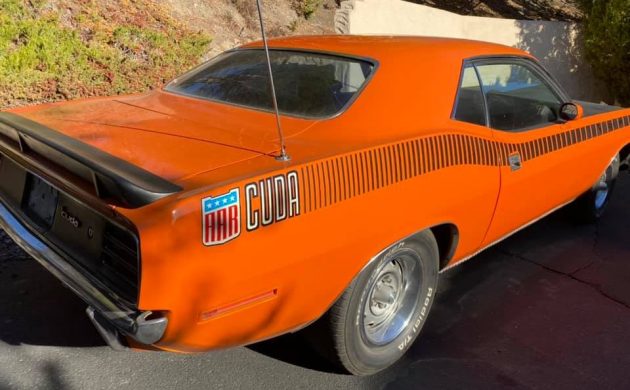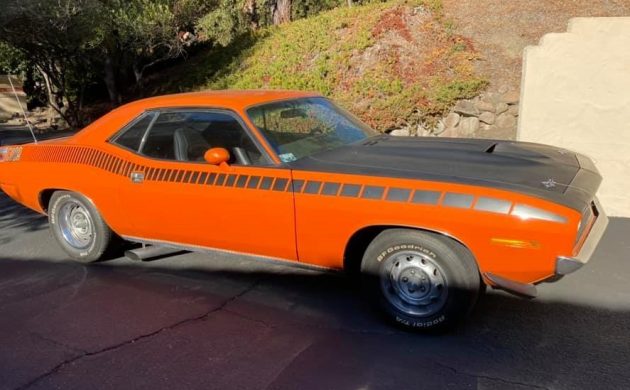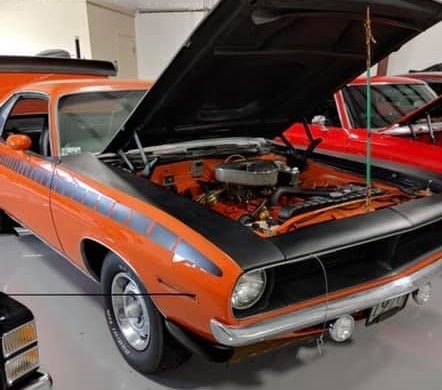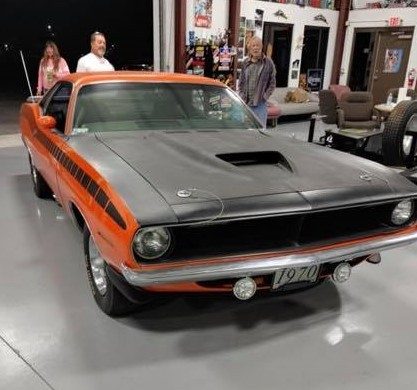Plymouth offered a lot of hot cars in the early 1970s and one of them was the AAR ‘Cuda, named after Dan Gurney’s All-American Racers in the Trans-Am Series. It was a potent muscle car produced in limited quantities using a 340 small-block with a 6-Pack set-up. It was a one-hit-wonder and only produced for the 1970 model year. This AAR ‘Cuda is an older restoration done around 2005. It no longer wears its 6-Pack plumbing, but the original intake and carb set-up are in the trunk. The car is located in Los Altos, California, and available here on Facebook Marketplace for $65,000.
In a deal with Plymouth, Trans-Am team owner Dan Gurney ran the 1970 AAR ‘Cuda with Swede Savage behind the wheel. The cars were hot on the track (and in the streets), but they did not win a race that season. In street form, the 340 – the only engine available in the AAR ‘Cuda – was rated at 290 horsepower with its triple 2-barrel carbs (compared to 275 for the single 4-barrel carb in the ‘Cuda 340). Smaller displacement engines like this found greater acceptance in insurance circles than their big-block brethren. Dodge offered a similar package in its Challenger pony car called the T/A.
The AAR ‘Cuda’s triple carbs were able to breathe through a fiberglass cold-air-induction hood that let fresh air in. A seal between the hood and the air cleaner pushed fresh air down the carburetor throats. NASCAR-style hood pins locked the fiberglass hood in position. Plymouth built on 2,724 AAR ‘Cuda’s for 1970, all produced within the months of March and April. 1,110 of them came with 4-speed manual transmissions, while the other 1,614 came with the Chrysler 727 TorqueFlite automatic. The seller’s car would be one of the latter.
We’re not told a lot about this car and no photos of the interior or trunk are provided. The car was treated to a restoration about 15 years ago, which likely included a new paint job which is looking a little tired at this point. I can’t put my finger on the exact color choice because there were at least three in the red/orange family, but I’m going with Vitamin C Orange as the hue on this automobile. There is no visible rust in what we can see, and the seller mentions no body damage of any kind.
This ‘Cuda has about 74,000 miles on it and, unfortunately, no longer sports its triple-barrel carb set-up, which is the greatest selling point of one of these cars. Apparently, at the restoration, a decision was made to go with a typical 340 set-up with a single 4-barrel. However, all the 6-Pack hardware has been saved, tucked away in the trunk, and I suppose the buyer could convert it back. Three online sources quote the resale value of one of these cars in the high five-figures. Old Cars Report Price Guide about a year ago said that one in No. 1 condition would go for $85,000. So, the seller’s asking price seems to account for the change in engine components and the age of the restoration.







Why remove the six pack?
I know someone who did the same to his T/A.
Less trouble and challenger still ran strong.
It looks legit and honest enough but FB Marketplace is as sketchy as it gets for a sale of any kind like this.
This is also listed on craigslist.
“Arr, matey”,( in my best Sea Cap’n voice),,I remember some real AAR beaters. They weren’t like a big block Cuda, and as such, people drove them harder. I think they were kind of cheap, offered plenty of thrills, but just had to be driven harder than a big block. Few survived. If rust didn’t kill them, the pump jockey did impressing his buddies. Not sure why someone would take off the 6 pack, it’s crowning feature, it ran on the center 2 barrel without your foot in it, temptation, maybe? Cool find and a wonderfully inflated California price tag, to boot.
I’ve heard all multiple-carb mopars were a bear to keep tuned. As a daily driver, which this may have been at one point. A single carb would have been much more user friendly. At least the previous owner kept it.
These were rare cars even when new! The center running 2 barrel was probably reliable. Restoring and running these carbs can be expensive, leak prone and hard to find even at swap meets. Probably not worth the hassle unless it is a show car. A big 4 barrel can make more CFM flow anyway.
Total CFM on the three carbs was 1350 so no single 4 BL had that much. .
I had a good friend of Cuban descent who had one of these. He painted a middle-bar in the D of CUDA to make it say CUBA.
My 440 6bbl ’70 GTX ran perfectly!
But; why change the ‘wow’ factor!?
Tho 1970’s Sunoco 260 was .35/gal;
give or take a nickel…
Years ago at the Mopar Nationals I asked a AAR owner why so many of the cars had the standard dash and no console and he said Plymouth dealers were forced to order these to make homologation standards for T/A so they didn’t add to many extra options
Is it original motor ? Heads were different on 340 six pac, also bottom end.
Probably the most street freakish factory car ever built, both the AAR’Cuda and Challenger TA, right down to the exhaust pipes. I wonder how much that six pack intake is worth by itself, and if it was removed for the value alone. A good four barrel set up isn’t exactly a slouch, but the wow! factor of three deuces under the hood is solid eye candy.
If I remember right the AAR and TA heads had different ports and push rod angle. Maybe those heads are gone and the six pack wouldn’t fit the standard 340 heads? It’s been 40 years since I played with these, so don’t beat me up to bad if I’m wrong. LOL.
I still own mine, 48 years. 340 TA block had thicker main webs to help installation of 4 bolt main caps. The heads had standard ports and bolt pattern, but the intake pushrod holes where “moved” to facilitate intake porting, thus the offset intake rockers unique to these heads. (W-2 uses same intake rockers) The blocks have TA cast in them, so they are easy to identify. These cars also came with heavier springs and rear sway bars standard. I never really had any problem with “tune” on the carbs. Stock, the outboard carbs use vacuum for opening as they have no accelerator pumps. Engines also were standard with dual point distributor. As far as I know, they all had front disc brakes and 11″ rear drums. They also have a “trim tag” on the fender well next to the options tag that is stamped Trans Am. They were planned for 1971, then when Chrysler dropped out of Trans Am racing, they were dropped. There were a few magazine ads promoting the 1971 models, usually the Dodge TA.
I had a white/black AAR and my brother had a yellow/black one…both Torqueflites/727s and vinyl roofs (which looked pretty good with the black hood and trim). They were nice cars. Very different character than my ’69 Z-28 (4-spd)…more like our ’70 ‘Z’ (automatic). The AAR was pretty comfy, handled nicely for the day, and had decent power and brakes. We never had any tune/mechanical issues the few years we had them. A nice package. This one looks pretty decent (except the orange is an acquired taste…) but really don’t follow the prices on such things since I don’t have/want any of them now.
One of the, then, unique things was the front and rear tires were 2 sizes different (E60 – 15 (F); G60 – 15 (R)). This one looks like they may be all the same size, but the wheels look factory original IIRC.
I sorta recall that I also used a prop stick to keep the hood up but that makes no sense now (? I think the factory springs didn’t keep it open?..it was a heavy hood.)…and at the time,e NJ state-run inspection station gave me a hard time about the exhaust tips in front of the wheels…not sure what I did then :-) …. then again they didn’t much like the headers and chambered exhaust on the ’69 Z either. :-)
Those were the days…
I am pretty sure the hood was fiberglass so should not have been as heavy as the metal one.Most of these the hoods are warped in the middle .I almost bought one but the car engine was not the original and passed on that one.
Yes, they were fiberglass, but not all that light. (I recall that mine incurred a crack in the front in some way which I forget…)
Look closely and you can see the orange one here has a prop stick too. It may be that the spring didn’t hold it high enough for safety and/or mechanical work.
Yes this one has no springs at all on the hinges so for sure a prop rod was needed.
I considered purchasing one just like this in the mid 1980’s from the original owner who owned a speed shop. I could have bought it then for $5k. I come from a GM family so was threatened if I were to purchase it, I wouldn’t get much help working on it. That car had only one rust hole from the back window area rusting in the corner and water ran down behind 1/4 panel and created a small rust hole behind wheel opening. Car was rarely driven and garage kept. Ended up being sold to a collector, after owner was pressured to sell from the wife. I ended up buying a 1969 Firebird coupe from the original owner for $2k and still own that car today. Often wonder where that AAR Cuda is today.